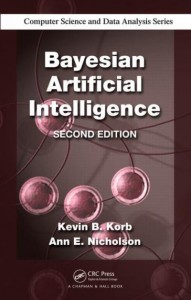Bayesian Artificial Intelligence, Second Edition by Kevin B. Korb and Ann E. Nicholson is among one of the very few books which explain the probabilistic graphical models and Bayesian belief networks in a balanced way; i.e. without making it a mathematical exercise in futility or by dumbing it down too much to make it a ‘practical guide’. This book is an interesting read and knowing the KDD genre, it’s few and far between when one can say these words about a machine learning book.
Bayesian Artificial Intelligence is organized into three main sections; probabilistic reasoning, learning causal models and knowledge engineering. The book discusses Bayesian networks as a function of their usage i.e. for reasoning, learning and inference. Book begins with an introduction to Probabilistic Reasoning where authors discusses Bayesian reasoning, reasoning under uncertainty, uncertainty in artificial intelligence, probability calculus and other related concepts. Authors then provide a primer of Bayesian networks before discussing inference in Bayesian Networks. In the chapter titled applications of Bayesian network, authors elaborate on different types of applications and their practical implementations. In the second part authors focus on learning the causal models, learning the probabilities from datasets, Bayesian Network classifiers, learning linear causal models, learning discrete causal structure and so on. The third section concentrates on knowledge engineering with Bayesian Network; it has a long chapter which talks about different aspects of knowledge engineering for example KEBN life cycle, Bayesian network modeling, how Bayesian structure is build, kept and developed etc. Finally we see the case studies for different sections and the software packages associated with it.
I personally really enjoyed this book mainly because it’s to the point, precise and well written. Due to the wide range of the field of machine learning and implementation of Belief networks, it becomes quite challenging to comprehensively cover the area. If you would like to read more about the general graphical models and probabilistic graphical models in machine learning, there are other texts out there however if your focus is Bayesian Artificial Intelligence and the belief networks, this book is quite useful.
The book is not written as a typical text book but still provides a set of problems at the end of each chapter. For theorem solvers and theory lovers, there are also various theoretical issues discussed in this book throughout related to the Bayesian provability and probability calculus. Overall it is not a so called ‘math heavy’ or theorem proving text but rather quite practical introduction to Bayesian AI. I highly recommend this book if you would like to learn Bayesian AI, Bayesian belief networks, Bayesian inference, learning, reasoning or any pertaining disciplines.

